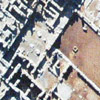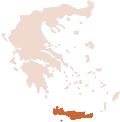Zakros
 The palace of Kato Zakros is located at the eastern end of Crete at the slopes of a low rocky hill and surrounded by rugged mountains to the east. A stone paved road took the inhabitants from the palace entrance to the nearby harbor which was easily reached in a few minutes by foot.
The palace of Kato Zakros is located at the eastern end of Crete at the slopes of a low rocky hill and surrounded by rugged mountains to the east. A stone paved road took the inhabitants from the palace entrance to the nearby harbor which was easily reached in a few minutes by foot.
The Zakros harbor is better sheltered and suitable to host a large fleet of commercial or military vessels, than Palekastro a little to the North. Many vessels coming from the East probably found it more convenient to unload their cargo at Zakro, than trying to sail around the ever-windy cape Sideros at the north-east tip of Crete. To the east the "Gorge of the Dead" that slices the rocky mountains connects the palace to the modern day Epano Zakros, and beyond to the mainland. The inhabitants of Zakros must have been able to make a living from the sea because there is not sufficient fertile land around the site to sustain a large population through agriculture.
Zakros is the smallest of the known Minoan palaces, about five times smaller than Knossos, and its location nearest the commercial destinations of Egypt, Cyprus and the Middle East transcended it to an important hub for economic and military activity. Like the other Minoan palaces of Crete, it was built around 1900 BC and most of the ruins date back to the Neopalatial period. Surrounding the palace was a thriving city, and the palace was the administrative, commercial, and religious center for the entire area. Many of the buildings were multistoried, with interior staircases, and light wells. Since the palace of Zakro was built on very wet land, water was always an element that needed to be addressed. The palace features a number of drains, a cistern, and a fountain were built.
 The palace plan follows the typical minoan outline, with its large central court flanked by buildings for cult, storage, administration, and public events. To the east of the main court were the chambers for the king and the queen, and to the west rooms for religious activities and public events. The "Treasury of the Shrine" is the only such room that was found untouched by robbers and yielded a great deal of precious artifacts. The wealth of imported materials such as ivory, various metals, and semi-precious stones testifies to the intense commercial activity of the palace. A large amount of rare clay tablets inscribed in Linear A were also unearthed from the Archive room. Many of the surviving tablets were preserved because they baked during the fire that destroyed the palace in 1450.
The palace plan follows the typical minoan outline, with its large central court flanked by buildings for cult, storage, administration, and public events. To the east of the main court were the chambers for the king and the queen, and to the west rooms for religious activities and public events. The "Treasury of the Shrine" is the only such room that was found untouched by robbers and yielded a great deal of precious artifacts. The wealth of imported materials such as ivory, various metals, and semi-precious stones testifies to the intense commercial activity of the palace. A large amount of rare clay tablets inscribed in Linear A were also unearthed from the Archive room. Many of the surviving tablets were preserved because they baked during the fire that destroyed the palace in 1450.
Zakros Pictures Highlights
 |
 |
 |
| The Treasury of the Shrine was not robbed, and it produced many important Minoan artifacts. | Aerial Picture of Zakros. From the Sitia Museum Exhibit. |
Storage room picture with some wall painting still visible. |
Zakros Artifacts at the Heraklion Museum
|
||
 |
 |
 |
 |
 |
 |
Zakros Artifacts at the Sitia Museum
|
||
 |
 |
 |
| Linear A Script Clay tablet | Linear A Script Clay tablet | Linear A Script Clay tablet |

